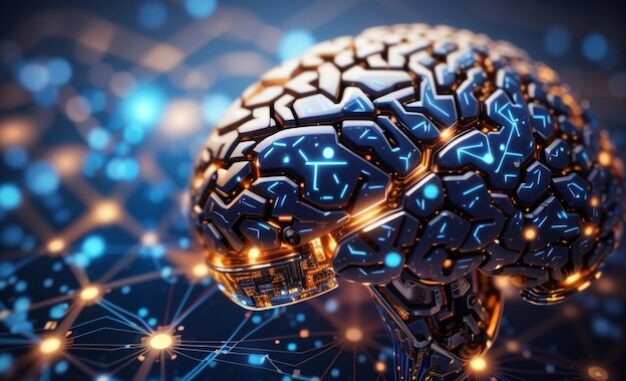
Neuromorphic computing, inspired by the brain’s architecture and processes, has the potential to revolutionize various fields
through its unique approach to computation. Here are some key applications of neuromorphic computing:










AI Applications of Neuromorphic Computing:
1. Robotics
Neuromorphic computing enhances robotics by improving perception, decision-making, and motor control.
Perception: Neuromorphic systems can process sensory information from cameras, microphones, and other sensors in real time, allowing robots to understand and interact with their environment more effectively.
Motor Control: Neuromorphic chips can be used to control robotic limbs with high precision, enabling smooth and coordinated movements.
Adaptive Behavior: Robots equipped with neuromorphic processors can learn from their environment and adapt their behavior, improving performance in dynamic and unstructured settings.
2. Healthcare
Neuromorphic computing is being used to develop advanced medical devices and systems.
Brain-Machine Interfaces (BMIs): Neuromorphic systems can interpret neural signals for controlling prosthetic limbs or other assistive devices, enabling more natural and intuitive control for users.
Neuromodulation Therapies: Neuromorphic devices can deliver targeted electrical stimulation to specific brain regions to treat neurological disorders such as epilepsy, Parkinson’s disease, and chronic pain.
Medical Imaging: Neuromorphic processors can enhance the analysis of medical images, providing faster and more accurate diagnostics.
3. Artificial Intelligence
Neuromorphic computing can improve the efficiency and scalability of AI algorithms.
Pattern Recognition: Neuromorphic systems excel at tasks like image and speech recognition due to their ability to process information in parallel and in real time.
Autonomous Systems: Neuromorphic AI can be used in autonomous vehicles and drones, enabling them to navigate complex environments and make real-time decisions.
Cognitive Computing: Neuromorphic processors can be used to develop systems that mimic human cognitive processes, such as learning, reasoning, and problem-solving.
4. Internet of Things (IoT)
Neuromorphic computing can enable low-power, real-time processing in edge devices.
Smart Sensors: Neuromorphic chips can be integrated into IoT sensors to process data locally, reducing the need for constant cloud connectivity and enhancing privacy and security.
Edge Computing: Neuromorphic processors can perform complex computations at the edge, enabling faster and more efficient data processing for applications like smart homes, industrial automation, and environmental monitoring.
Energy Efficiency: Neuromorphic systems are designed to operate with low energy consumption, making them ideal for IoT devices that need to run on limited power sources.
5. Security and Surveillance
Neuromorphic computing can improve the efficiency and accuracy of security and surveillance systems.
Real-Time Monitoring: Neuromorphic processors can analyze video feeds in real time, detecting and alerting to unusual activities or potential threats.
Facial Recognition: Neuromorphic systems can perform complex pattern recognition tasks such as facial recognition with high accuracy and low latency.
Anomaly Detection: Neuromorphic algorithms can learn to recognize normal patterns and detect anomalies, which can be critical for security applications.
6. Finance
Neuromorphic computing can enhance financial systems by providing faster and more accurate data analysis.
Algorithmic Trading: Neuromorphic systems can process and analyze large volumes of financial data in real time, enabling more efficient and effective trading strategies.
Fraud Detection: Neuromorphic algorithms can identify unusual patterns and behaviors that may indicate fraudulent activity, improving the security of financial transactions.
Risk Management: Neuromorphic processors can be used to assess and manage financial risks by analyzing complex data sets and identifying potential threats.
7. Education and Research
Neuromorphic computing can advance educational tools and scientific research.
Intelligent Tutoring Systems: Neuromorphic AI can be used to develop personalized learning systems that adapt to the needs and progress of individual students.
Scientific Simulations: Neuromorphic processors can simulate complex biological and physical processes, helping researchers to understand and explore new scientific phenomena.
Data Analysis: Neuromorphic computing can enhance the analysis of large and complex data sets, enabling new insights and discoveries in various fields of research.
8. Smart Infrastructure
Neuromorphic computing can improve the management and efficiency of smart infrastructure systems.
Smart Grids: Neuromorphic processors can optimize the distribution of electricity in smart grids, reducing energy waste and improving reliability.
Traffic Management: Neuromorphic systems can analyze traffic patterns in real time, optimizing traffic flow and reducing congestion in smart cities.
Building Automation: Neuromorphic AI can be used to control and optimize heating, cooling, lighting, and other systems in smart buildings, enhancing energy efficiency and comfort.
9. Environmental Monitoring
Neuromorphic computing can enhance the monitoring and protection of the environment.
Wildlife Tracking: Neuromorphic sensors can be used to monitor and track wildlife, providing valuable data for conservation efforts.
Pollution Detection: Neuromorphic systems can detect and analyze pollutants in air, water, and soil, helping to identify sources of pollution and mitigate their impact.
Climate Modeling: Neuromorphic processors can simulate and predict climate patterns, aiding in the understanding and response to climate change.

Leave a Reply